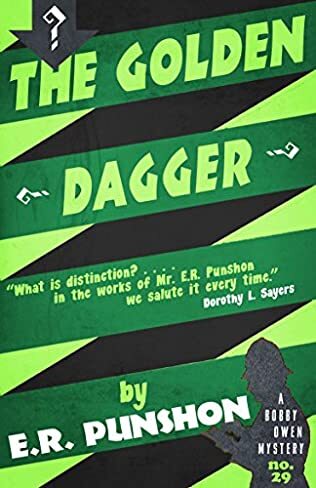The Golden Dagger

A review of The Golden Dagger by E R Punshon – 250528
E R Punshon took a bit of a risk in setting the twenty-ninth in his Bobby Owen series at Cobblers. Originally published in 1951 and reissued by Dean Street Press, it is not exactly a load of cobblers but, in my view as a fan of Punshon’s work, it is one of his weakest. It reads like a wheezy old car gamely ascending a steep hill, barely able to get out of second gear, only picking up speed as the summit heaves into view.
The mystery starts with a phone call telling the police that the valuable Cellini dagger, one of the most valuable items in Lord Rune’s art collection at his home at Cobblers, is to be found in a nearby phone box and that a murder has been committed. The dagger is found covered in blood but there is no sign of a body. Armed with this scanty information Bobby Owen, Punshon’s go-to detective who is now an Assistant Commissioner at the Yard with a floating brief, sets out to find out what has been going on. Naturally, he succeeds, but even though he is convinced of the culprit’s identity – after all, if the hat fits, especially a black homburg size six and seven-eighths – but is short of evidence that would convince a jury to pass a guilty sentence. Owen’s difficulties are solved when the culprit takes justice in their own hands.
My principal problem is that much of the book is irrelevant to the actual case, a series of red herrings that are as much about padding the book out as putting the reader off the scent. The identity of the culprit, who in terms of page count plays a relatively minor part in the story, is pretty obvious. There are a couple of significant clues that a seasoned reader of the genre in general and Punshon in particular will not fail to spot which, with over a hundred pages to go, make it all clear.
Nevertheless, Punshon embeds a fairly straightforward case of blackmail and the thwarting of marital infidelity in a cocoon of a world made up of eccentric peers and members of the literary and theatrical world. There are suggestions that Rune is selling off the prize treasures of his collection and replacing them with copies to fund a lifestyle that is hard to sustain on the maximum income of £6,000 allowed at the time and to spite his heir whom he despises. His secretary seems to be part of a plot to steal stamp collections, an author, going by the unlikely pseudonym of Tudor King, has disappeared, his housekeeper strikes a Clytemnestra-like figure as she keeps an axe handy, and Rune’s new servant seems to be up to no good, making frequent nocturnal visits to a nearby house.
The stand out character is Rune’s daughter, Maureen, who is both independent and strong-willed with a misplaced sense of family loyalty that persuades her to be economical with the actualité and not to have any qualms about destroying crucial evidence. She is also a man magnet, attracting not necessarily the most desirable sorts but ones who might help her fulfil her ambition of making it in the theatre. She is a handful and the battle of wills between her and Owen is one of the highlights of the book.
The other highlight is the obligatory Punshon set piece, set in a mist-shrouded wood where Owen is desperately trying to rescue a wounded woman and at the same time rescue a hat and apprehend someone blundering about who is wearing a mask and has a scratched face. Ludicrously, three turn up who could fit the bill, but the truth will out.
Although the plot is disappointing, Punshon’s writing is still a delight, his dialogue convincing and laced with humour and social observations. By his standards it is far from his best, but it is enjoyable, nonetheless.



